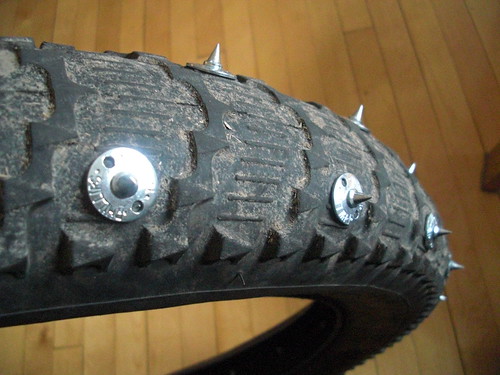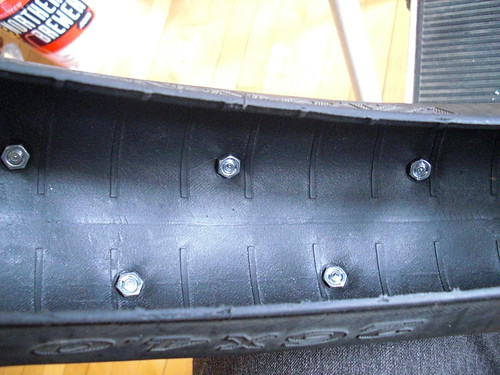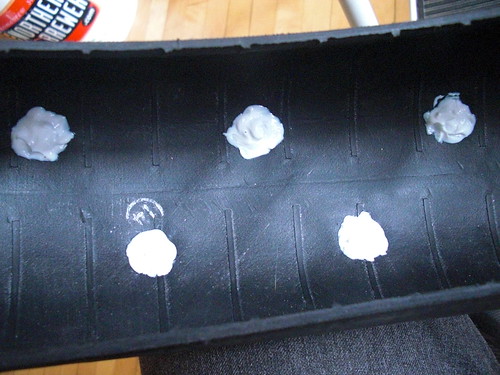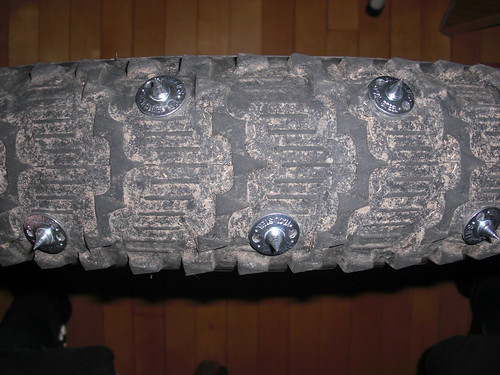Having switched to the knobbies for the winter, there was an immediately noticeable increase in rolling resistance. It was enough that I would have increase tire pressure or change my rear cog. Or use a different tire. After riding my Endomorphs on the dirt during the summer, they were 1/2 shagged, and not worthy of use in the snow anymore. I also rode a lot of icy trails last year, and was wishing I could have some studded tires as well. The thought to stud out the Endos had occurred to me, but the knobs were small to start with, and now they were half worn out. I wanted and aggressive stud, and I didn't think the lugs would support much.
Here is what I came up with:

50 studs per tire, adding 1/2lb per tire, and costing a smidge over $25 per tire. The studs are not in the lug of the tire, but through the casing, between the lugs/knobs. If I do say so myself, they are supurb for hardpacked/groomed trails and ice. I have got to say it is rather fun being able to rail the corners while others have to take it easy. If you have inches of fresh snow, they are terrible. I will probably have a second set of wheels for next year with the knobby tires mounted to them so I can change out tires quick and easy depending on the days conditions. One would not want to ride these on anything but snow or ice. Not across the parking lot to the trail head, not on streets or paved trails, and not across the exposed rocks on the trail, if you can avoid it!
Also, I have only tested these on about a handful of times in the last half of this winter. The front tire seems to be fine with my construction method, but the rear needs some improvement as I have lost about five or so studs from the tire. One was lost when I attempted a log ride, and in realizing my rear tire was going to slide of, I locked up the rear brake in trying to save myself. When the tire slid off the log, with all of my weight still on the bike, one of the studs grabbed in the log, and pulled out of the tire. The other missing studs... well, I can't say what happened to them, but they are no longer in the tire!
Riff on this approach if you are interested in making your own homebrew studded fat tires, eh:
Gather your supplies.
1) 100 steel caulks (50 per tire). Caulks are apparently used in the soles of boots for lumberjacks and jills. I got a pack of 100 to do both tires from these folks: http://www.labonville.com/Steel-Spikes--SS1_p_267.html $18.95
2) A spike wrench. You could do it without one, but you wouldn't want to have to. And they are not expensive. http://www.labonville.com/Pro-Wrench-for-Spikes--SW2_p_268.html $5.95
3) 100 nuts (50 per tire). The Caulks have a funny thread to them that is not commonly available. The ones I purchased were M6x.75. Coincidentally, this is the same threading as a presta valve nut, though I wouldn't use these even if you had 100 of them as they would be difficult to fully tighten. McMaster-Carr had one option for M6x.75 nuts, of which I purchased two 50 packs. http://www.mcmaster.com/#91415A040 2 x $7.39/ea
4) Caulk. Not the spike caulks previously mentioned, but the kitchen and bath kind. This is to cover over the nut on the inside of the tire so the tube isn't punctured by any sharp edges. There is probably a better product for this, but I happened to have a tube open and available in my shop.
5) Duct tape. This is to cover the caulked caulk nuts. Just to be sure I don't puncture any $16 fat bike tubes, eh.
6) A drill bit and drill. If you don't already have these tools, wtf are you doing making your own studded tires?
7) 10mm socket on a ratchet, probably with an extension.
8) Several beers and several hours of free time to kill.

The instructions are even easier than the supplies list. Drill undersized holes. Curse me and my stupid idea as you struggle to get those damn caulks inserted into the tire. Use the spike wrench and a clockwise twisting motion. You really do not want the drilled holes any larger than they absolutely have to be. Hand thread on the nut, then really tighten the heck out of it with the ratchet and spike wrench to ensure the caulk is fully installed. In my case, the threaded stud of the caulk was flush with the nut when fully tightened. Cover nutted caulk with caulk - make it smooth! Allow caulk to cure (took me two days). Cover caulked caulk nuts with a square of duct tape. Sweep up all the little bits of drilled rubber off the living room floor before your old lady gets pissed at you about it. Put your tools away. Install tires on wheels, as per usual. Go ride a bike, eh!

P.s. these bad motha truckas are sharp as can be. I had a get-off whilst attempting to ride in a few inches of fresh snow (not recommended, see above). When I went off trail, my bicycle stopped, I kept going, and my knee hit my front tire. Normally not a big deal, unless of course, you have 3/8" needle sharp spikes in your tires. If you stud your tires in this way, you are pretty much guaranteed to either draw blood, or destroy a nice, fancy piece of expensive technical clothing. Consider yourself forewarned.

Disclaimer: You are an adult, you can make your own choices. Go ahead, jump off this homebrew studded fat tire bridge because I told you to.
No comments:
Post a Comment